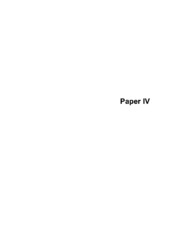| dc.contributor.author | Tveito, Torill Helene | |
| dc.date.accessioned | 2007-02-12T09:30:24Z | |
| dc.date.available | 2007-02-12T09:30:24Z | |
| dc.date.issued | 2007-01-06 | eng |
| dc.identifier.isbn | 978-82-308-0309-7 (print version) | eng |
| dc.identifier.uri | https://hdl.handle.net/1956/2095 | |
| dc.description.abstract | The aims of this thesis were to identify risk factors for high levels of sick leave and investigate what – if anything – can be done to reduce sick leave. What is the role of “subjective health complaints”, coping, and psychosocial work factors in relation to sick leave, and to what extent do these factors and the sick leave relate to quality of life? Are there any interventions with a documented effect on sick leave in the literature? Is it possible to influence sick leave through an intervention tailored to target the risk factors for sick leave including both psychological and physiological health factors? Finally, the aim was to identify and describe employees with a high level of sick leave. “Subjective health complaints” are complaints without known pathology or where the pathological findings are less than expected. Such complaints are the cause of more than 50% of the sick leave in Norway. Musculoskeletal complaints are one subgroup of subjective health complaints and are responsible for nearly half of the sick leave. Low back pain is the most common diagnosis in this group. Employees in the health sector are the work group with most sick leave and highest recruitment to disability pension. In Paper 1 employees in two nursing homes for the elderly were assessed for subjective health complaints as well as for health related quality of life. In addition, personal and work factors were monitored. High levels of subjective health complaints did relate to low quality of life. High expectancies of being able to cope and low work demands were associated to high quality of life; and low coping expectancies and high work demands were associated to low quality of life. Since low back pain is the most common reason for sick leave and a frequent complaint among the employees in the nursing homes, the literature for work place interventions targeted at low back pain was searched. In Paper 2 the results from this systematic literature review of controlled work place interventions are presented. We identified 31 publications that satisfied our quality criteria. The inclusion criteria were: controlled intervention, work setting, and assessment of at least one of the four main outcome measures: sick leave, costs, new episodes of low back pain, and pain. All studies were scored on methodological quality. Physical exercise and comprehensive multidisciplinary interventions were the only interventions with a documented effect on low back pain. Physical exercise to prevent low back pain and comprehensive multidisciplinary interventions to treat employees with low back pain were effective in reducing sick leave, costs, and preventing recurrence of low back pain. In Paper 3 the effects of an intervention tailored to target the risk factors for sick leave including both psychological and physiological health factors related to sick leave are presented. Employees in one of the nursing homes from Paper 1 were invited to participate in an “Integrated Health Programme” consisting of physical exercise, health information, and stress management, in a randomised controlled study. The intervention group (n = 19) was allowed time off from work to participate in the intervention twice weekly for 9 months. The control group (n = 21) was offered the same “Integrated Health Programme” after the study was finished. The intervention had no significant effect on sick leave. Sick leave more than doubled in both groups during the intervention period. The intervention group reported less neck complaints compared to the control group, otherwise there were no effects on subjective health complaints. On the other hand, there were large positive subjective effects in the intervention group. The intervention group reported significant improvement in their experience of their own health, physical fitness, muscle pain, stress management, maintenance of health, and work situation. Still, this did not change the scores on health related quality of life. This may relate to the fact that the scores were about average for the group as a whole. Finally, in Paper 4, the distribution of sick leave in a population of power plant employees was described. A group of 10% of the employees was responsible for 82% of the sick leave, with an average number of 44 days of sick leave in the group of employees with much sick leave and 1 day in the group with low level of sick leave. The employees with much sick leave were characterised by high levels of subjective health complaints, low education, low coping, heavy manual work, and many health risk factors such as smoking, low job satisfaction, high reports of job stress, poor quality of sleep, and low level of physical activity. With sick leave among the employees distributed like this, demonstrating effect on sick leave of an intervention including all employees will be difficult. The conclusion from the thesis is that a minor part of the employees had the major part of the sick leave. The employees with much sick leave were characterised by having high levels of subjective health complaints, an unhealthy life style, low coping, a reduced quality of life, and low socioeconomic status. Subjective health complaints were important for daily life functioning. High coping and low job demands were associated with high quality of life. Physical exercise interventions at the work place had a documented effect on sick leave. A work place intervention including physical exercise was not effective in reducing sick leave and subjective health complaints, but had large subjective effects. The potential for reducing sick leave is small when targeting all employees in an organisation and this may explain why so few of the interventions aiming to reduce sick leave, including the one in this thesis, are effective. | en_US |
| dc.format.extent | 218707 bytes | eng |
| dc.format.extent | 142560 bytes | eng |
| dc.format.extent | 129108 bytes | eng |
| dc.format.extent | 126841 bytes | eng |
| dc.format.extent | 141444 bytes | eng |
| dc.format.extent | 409018 bytes | eng |
| dc.format.mimetype | application/pdf | eng |
| dc.format.mimetype | application/pdf | eng |
| dc.format.mimetype | application/pdf | eng |
| dc.format.mimetype | application/pdf | eng |
| dc.format.mimetype | application/pdf | eng |
| dc.format.mimetype | application/pdf | eng |
| dc.language.iso | eng | eng |
| dc.publisher | The University of Bergen | eng |
| dc.relation.haspart | Paper I: Psychology and Health 19(2), Tveito, T. H.; Passchier, J.; Duivenvoorden, H. J. and Eriksen, H. R, Subjective health complaints and health related quality of life in a population of health workers, pp. 247-59. Copyright 2004 Taylor & Francis. Published version available at:<a href"=http://dx.doi.org/10.1080/08870440310001613491" target=_blank>http://dx.doi.org/10.1080/08870440310001613491</a> | eng |
| dc.relation.haspart | Paper II: Occupational Medicine 54(1), Tveito, T. H.; Hysing, M. and Eriksen, H. R., Controlled low back pain interventions at the workplace : a systematic review, pp. 3-13. Copyright 2004 Oxford University Press. Published version available at: <a href"=http://dx.doi.org/10.1093/occmed/kqg109" target=_blank>http://dx.doi.org/10.1093/occmed/kqg109</a> | eng |
| dc.relation.haspart | Paper III: Tveito, T. H. and Eriksen, H. R, Improving health in health workers: a randomised controlled trial of physical exercise, health information, and stress management. Preprint. Submitted Journal of Advanced Nursing. Published by Blackwell Publishing. | eng |
| dc.relation.haspart | Paper IV: Norwegian Journal of Epidemiology 12(1), Tveito, T. H.; Halvorsen, A.; Lauvålien, J. V. and Eriksen, H. R., Room for everyone in working life? 10% of the employees – 82% of the sickness leave, pp. 63-8. Copyright 2002 The Norwegian Epidemiological Association. | eng |
| dc.title | Sick Leave and Subjective Health Complaints | eng |
| dc.type | Doctoral thesis | |
| dc.subject.nsi | VDP::Samfunnsvitenskap: 200::Psykologi: 260 | nob |
| dc.subject.nsi | VDP::Medisinske Fag: 700::Helsefag: 800 | nob |




